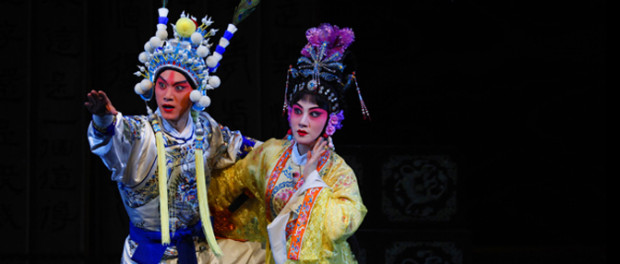East Meets West in the Revenge of Prince Zidan Opera
Whenever I think I’ve gotten jaded and think I’ve seen it all, something comes along and slaps me across the face, “There are more things in heaven and earth, Horatio, Than are dreamt of in your philosophy.”
In this case, Chinese opera.
The Shanghai Jingju company’s Revenge of Prince Zidan is a retelling of Hamlet. The key characters are there — Hamlet, Ophelia, Horatio, Claudius, Gertrude — only they have Chinese names. The story more or less follows the plot of Hamlet, with Prince Zidan finding out that his evil uncle has murdered Prince Zidan’s father (the king) and is shacking up with his mother. A ghost compels Zidan to seek revenge, something he does by feigning madness at court and spurning his girlfriend. Even some of Shakespeare’s solilioquies and famous lines, such as the “to be or not to be” speech, are part of the production.
Prince Zidan, though, isn’t Hamlet-serious-weight-of-tradition-drama a la Kenneth Branaugh or Hamlet-for-kids a la the Lion King. It isn’t slicked up Hollywood style, or downgraded for bored teens. Instead, Prince Zidan is both earthier and more formal in its interpretation than any recent version of Hamlet I’ve encountered. In a way, this is what opera, and Shakespeare, should be like. It is entertainment for the masses: big drama surrounding social elites, outrageous costumes of wealth, moments of hilarity, acrobatic stunts, and no one getting overly pretentious about the whole thing. There’s plenty of fake beard stroking, a full size actor portraying a midget, and some over-mothering.
While the show provides a full spectacle of entertainment, it also is sung and spoken in Chinese, using aspects of traditional Chinese opera and drama, as if to give a full sampler plate of what this entails. Masks, particular types of face paint, and deliberate movements and gazes are used to convey the story. To the sides of the stage, screens provide translations, though glancing at these took away from watching the stage. The story of Hamlet is familiar enough, anyway. I won’t comment any further on the oddity of seeing Shakespearean English and everyday French presented one atop the other as if they were equivalent translations.
Prince Zidan’s arrival on stage with the Horatio-character is as funny and as unexpected as it is compelling. Two peacock feathers rise out of his elaborate headdress like antennae, rendering . The two men perform a choreographed dance that entails some splits and leg raises of the most athletic. The audience, presumably unaccustomed to any kind of performance, felt the need to clap every time Prince Zidan held his leg in an unnatural position. As the two men carried out the scene, their emotive painted faces and deliberate body movements built the tension.
I generally dislike the pomp and artifice of opera singing from the Western tradition. I can’t say Chinese opera singing was any more accessible. The pentatonic scale sounds harsh and less lush than traditional western music. The women sing in glass breakingly high pitches.
A fantastic band composed of traditional Chinese instruments provided music for the opera. Every gesture and scene had music that enhanced the emotion. The music was heavier on cymbals and percussives than we are used to. A stringed instrument and flutes provided a lot of the music as well. Since they were positioned off to the side of the stage, only during curtain call did it become apparent that the band had around 15 members.
Overall, the Revenge of Prince Zidan is worth seeing for its good story, its ability to present opera in a way that can appeal to non-opera types, and its melding of East and West. The entire production knows when to take itself seriously and when not to. I highly recommend it as something one is unlikely to encounter again.
The Revenge of Prince Zidan is at Place des Arts from Feb 15 – March 1.






